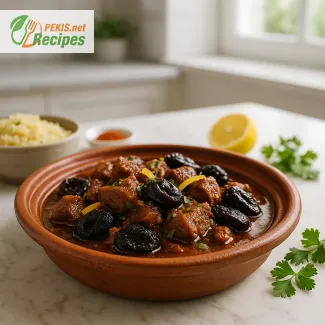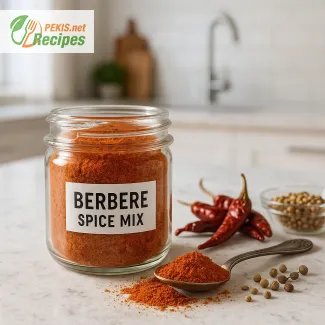A North African tagine with prunes brings together tender slow-cooked meat, warm spices and jammy, caramel-soft prunes that melt into a glossy sauce. Rooted in Moroccan tradition, the dish blends sweet and savoury notes into a rich, comforting stew where every bite feels both rustic and luxurious.
Knowing how slowly cooked spices evolve, a small trick makes this North African tagine with prunes even richer: letting the prunes soak briefly in warm stock before adding them creates a deeper, silky sweetness that blends seamlessly into the sauce. The balance of aroma, gentle heat and tender meat comes from patience, not complexity.
PEKIS – professional chef and recipe developer with more than 25 years of experience in cooking and baking, specialised in European and international cuisine.

Slow-cooked North African comfort stew with prunes and warm spices
A fragrant, tender and deeply aromatic tagine for soulful family meals
Steam rises in slow curls as the lid of a traditional clay pot lifts, carrying the scent of warm spices, soft onions and jammy prunes across the kitchen. The meat glistens, its surface lightly caramelised, and each piece is so tender it yields at the touch of a spoon. The sauce has turned glossy and dark, thickened naturally by the fruit melting into the broth. Long before the first bite, this North African tagine with prunes already feels like comfort — a dish shaped by time, tradition and patient heat. Its texture is part of the experience: silky, softly sweet and deeply savoury, with prunes that transform into pockets of caramel richness and spices that warm without overwhelming.
What makes this stew special is how its ingredients build upon each other. Aromatic spices like cinnamon, cumin, coriander and ginger open up slowly, releasing the kind of fragrance that fills the entire space with an earthy, golden warmth. Prunes lend depth and colour, their natural sweetness balancing the richness of slow-cooked lamb or beef. Preserved lemon cuts through that sweetness with a bright, salty tang. Every element finds its place, creating a layered result that tastes rustic yet polished.
History and origin of the prune tagine
North African cuisine has long embraced the pairing of meat with fruit, especially in Morocco, where tagines are both everyday meals and festive centrepieces. The method reflects resourcefulness: cooking over steady, low heat allowed families to stretch ingredients while developing flavor. Over generations, cooks discovered that adding dried fruits like prunes or apricots created a natural sweetness that made even modest cuts of meat feel celebratory. This particular version became associated with gatherings, weddings and family meals — a dish that carries the aroma of hospitality and shared tradition.
Flavor structure and key components
How the main ingredients influence the final result
Each part of this tagine contributes to its distinct character:
- Meat with gentle marbling turns succulent and soft, giving the sauce body.
- Onions cooked until sweet create a velvety base.
- Prunes melt into the stew, thickening it naturally and adding fruity depth.
- Honey rounds the edges for a subtle caramel sweetness.
- Warm spices add warmth, aroma and a softly spiced finish.
- Preserved lemon adds brightness and contrast.
- Toasted almonds give texture that breaks the softness of the stew.
For those who prefer grain-based sides, there is also a helpful companion recipe such as the English version of Couscous Recipe: Roasted Semolina Couscous with Veggies, which pairs beautifully with the glossy sauce and aromatic spices.
Texture and aroma explained
Slow cooking releases the natural collagen in the meat, transforming it into buttery tenderness. Prunes soften so completely they blend with the sauce, enriching it without the need for thickeners. Spices bloom early and linger through the entire cooking process, giving the stew that unmistakable North African perfume: warm, slightly sweet, earthy and comforting.
Storage and make-ahead guidance
The dish keeps exceptionally well thanks to its slow-cooked structure and rich sauce. Once cooled, it can be stored in the fridge for up to three days, with flavours deepening over time. Reheating on low heat restores the stew’s silky consistency; a splash of stock or water helps loosen the sauce if it thickens too much. Nuts and fresh herbs should be added only at the end to maintain their brightness and crunch.
Ingredient synergy: spices, fruit and preserved lemon
This dish thrives on contrast: the sweetness of prunes, the earthiness of spices and the zing of preserved lemon come together in a way that feels layered and thoughtfully balanced. Honey binds everything into a seamless whole, while toasted nuts provide a final crunchy flourish. For a harmonious dessert pairing, the structure of the spices and sweetness in this stew aligns beautifully with the decadent Pistachio Chocolate Baklava Cake – a Luxurious Layered Dessert for Special Occasions.
Why you’ll love this dish
- Deep, layered flavour created through slow cooking
- Balanced sweet-savoury profile with aromatic spices
- Tender texture from long, gentle heat
- Perfect pairing with couscous, flatbread or rice
- Ideal for gatherings, as it improves with rest
Creative variations
- Swap lamb for beef or chicken thighs for a lighter profile.
- Replace prunes with figs or apricots for a brighter sweetness.
- Add carrots or sweet potatoes to extend the dish for larger groups.
- Use a spice blend like ras el hanout for a more complex flavour.
- Finish with pistachios instead of almonds for added colour.
- Warm the olive oil in a heavy pot or tagine over medium heat. Add the lamb pieces and sear until lightly browned on all sides.
- Add the sliced onions and cook until soft and beginning to caramelise. Add the minced garlic and stir for 30 seconds until fragrant.
- Stir in cinnamon, cumin, coriander, ginger, paprika, turmeric, salt and pepper. Let the spices bloom in the hot oil for fuller aroma.
- Add the prunes, honey, preserved lemon and lamb stock. Mix well so the sauce coats the meat evenly.
- Cover the pot tightly and cook on low heat for 80–90 minutes, stirring occasionally, until the lamb becomes tender and the prunes soften into the sauce.
- Taste and adjust seasoning. If needed, simmer uncovered for a few minutes to thicken the sauce to a glossy consistency.
- Serve hot, topped with chopped coriander and toasted almonds.
FAQ questionWhat cut of meat works best for a North African tagine with prunes?
For this style of slow-cooked tagine, cuts with good marbling and connective tissue work best, because they turn meltingly tender over low heat. Lamb shoulder, beef chuck or bone-in chicken thighs are ideal. Lean cuts dry out easily and won’t develop the same buttery, pull-apart texture. The gentle simmer gives time for collagen to break down into silky gelatin, which thickens the sauce and makes each bite feel richer without adding extra fat.
FAQ questionWhy are prunes used and not another dried fruit?
Prunes bring a deep, dark sweetness that feels more caramelised and jammy than most dried fruits. They slowly dissolve into the sauce, giving the tagine a velvety body and a natural sweetness that pairs beautifully with cinnamon, cumin, coriander and ginger. Apricots or figs can be used, but prunes give the stew a more rounded, almost wine-like flavour, especially when combined with onions and honey. They also help balance the richness of the meat without making the dish taste like dessert.
FAQ questionHow do you keep the tagine from becoming too sweet?
The key is to balance sweetness with acidity and salt. Prunes and honey add sweetness, but preserved lemon, a splash of lemon juice, or a spoonful of tomato paste bring in bright, tangy notes that cut through the richness. Seasoning with enough salt and warm spices keeps the dish grounded and savoury. If the sauce tastes too sweet at the end, adding a little more lemon or stock and simmering briefly usually restores a harmonious sweet-and-savoury balance.
FAQ questionCan a North African tagine with prunes be made in a regular pot instead of a clay tagine?
Yes. A heavy-bottomed Dutch oven or casserole with a tight-fitting lid is a great stand-in for a clay tagine. The goal is to maintain gentle, even heat and prevent too much moisture from escaping. Keep the heat low, let the stew simmer quietly, and resist the urge to boil. If using a metal pot, you may need a little extra stock or water to prevent sticking, but the flavour profile—slow-cooked meat, soft prunes and aromatic spices—remains the same.
FAQ questionWhat can you serve alongside a tagine with prunes?
This dish is perfect with fluffy couscous, flatbreads or simple steamed rice that soak up the glossy, spice-infused sauce. For a balanced plate, add something fresh and crisp, like a herb and citrus salad or lightly dressed cucumber and tomato. If you enjoy more structured mains-and-sides plating, pair the stew with a grain-focused side such as the couscous from the roasted semolina style, which echoes the North African character while keeping the focus on the tender meat and prunes.
FAQ questionIs this tagine suitable for meal prep and next-day serving?
Absolutely. A North African tagine with prunes often tastes even better the next day. As it rests, the flavours of spices, prunes and meat meld together, and the sauce thickens into a rich, spoon-coating consistency. For meal prep, cool the stew completely, refrigerate it in an airtight container and reheat gently over low heat, loosening the sauce with a splash of stock or water if it becomes too thick. Finish with fresh herbs and crunchy nuts just before serving to restore contrast and freshness.
The depth of a North African tagine with prunes comes from the way simple ingredients transform under slow heat. The spices bloom gently, the meat becomes fork-tender, and the prunes melt into a silky, dark sweetness that gives the sauce its unmistakable character. Each component shifts into harmony, creating a dish that feels generous, warm and layered.
Long cooking gives the stew its signature richness, but it also brings a sense of calm to the kitchen. The aroma of cinnamon, cumin and coriander builds gradually, signalling the moment the meat and fruit begin to soften together. What emerges is not just flavour but a sense of comfort rooted in tradition and patience.
The contrast between savory spices, jammy prunes and bright touches like preserved lemon makes every bite feel balanced and intentional. This combination keeps the stew from feeling heavy, allowing the sweetness and warmth to enhance rather than overpower.
A dish like this invites flexible serving ideas—couscous, flatbreads or rice all highlight the glossy, spice-infused sauce in different ways. With its ability to improve overnight and carry its flavours effortlessly, it works well for both family meals and special occasions.
What stays memorable is the harmony of textures and aromas. The tagine brings together soft fruit, tender meat and fragrant spices in a way that feels timeless, rooted and deeply satisfying.
Allergens present in the recipe:
- None of the major allergens are naturally present.
- May contain traces of nuts if almonds are used.
- Gluten-free when served without wheat-based sides.
Allergen and gluten replacement tips:
- Replace almonds with pumpkin seeds or sunflower seeds for a nut-free version.
- Serve with rice or gluten-free flatbread instead of wheat couscous or bread.
- If using store-bought stock, choose a gluten-free certified version.
- Vitamin B12 (µg): 2.1 – supports red blood cell formation
- Vitamin B6 (mg): 0.6 – aids energy metabolism
- Iron (mg): 4.5 – essential for oxygen transport
- Potassium (mg): 630 – supports fluid balance and muscle function
- Magnesium (mg): 48 – contributes to nerve and muscle health
- Zinc (mg): 6.2 – supports immunity and cell repair
- Polyphenols (mg): 120 – from prunes, beneficial for cellular protection
- Flavonoids (mg): 35 – contribute to anti-inflammatory effects
- Carotenoids (mg): 0.4 – support vision and skin health


